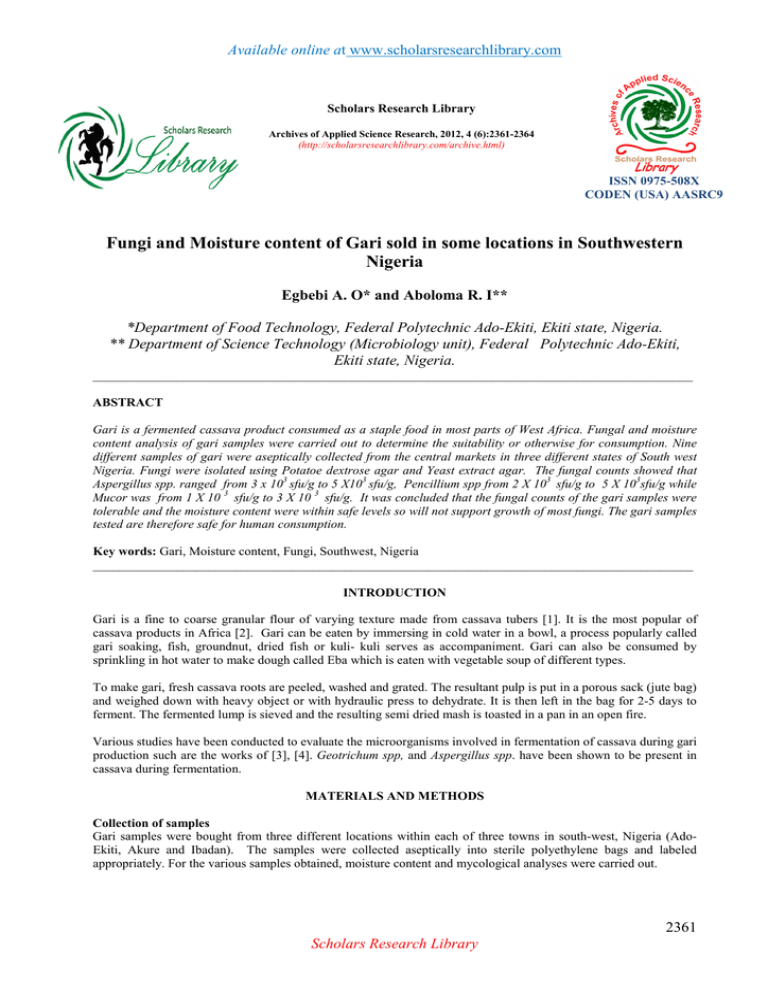Fungi and Moisture content of Gari sold in some locations in
advertisement

Available online at www.scholarsresearchlibrary.com Scholars Research Library Archives of Applied Science Research, 2012, 4 (6):2361-2364 (http://scholarsresearchlibrary.com/archive.html) ISSN 0975-508X CODEN (USA) AASRC9 Fungi and Moisture content of Gari sold in some locations in Southwestern Nigeria Egbebi A. O* and Aboloma R. I** *Department of Food Technology, Federal Polytechnic Ado-Ekiti, Ekiti state, Nigeria. ** Department of Science Technology (Microbiology unit), Federal Polytechnic Ado-Ekiti, Ekiti state, Nigeria. _____________________________________________________________________________________________ ABSTRACT Gari is a fermented cassava product consumed as a staple food in most parts of West Africa. Fungal and moisture content analysis of gari samples were carried out to determine the suitability or otherwise for consumption. Nine different samples of gari were aseptically collected from the central markets in three different states of South west Nigeria. Fungi were isolated using Potatoe dextrose agar and Yeast extract agar. The fungal counts showed that Aspergillus spp. ranged from 3 x 103 sfu/g to 5 X103 sfu/g, Pencillium spp from 2 X 103 sfu/g to 5 X 103sfu/g while Mucor was from 1 X 10 3 sfu/g to 3 X 10 3 sfu/g. It was concluded that the fungal counts of the gari samples were tolerable and the moisture content were within safe levels so will not support growth of most fungi. The gari samples tested are therefore safe for human consumption. Key words: Gari, Moisture content, Fungi, Southwest, Nigeria _____________________________________________________________________________________________ INTRODUCTION Gari is a fine to coarse granular flour of varying texture made from cassava tubers [1]. It is the most popular of cassava products in Africa [2]. Gari can be eaten by immersing in cold water in a bowl, a process popularly called gari soaking, fish, groundnut, dried fish or kuli- kuli serves as accompaniment. Gari can also be consumed by sprinkling in hot water to make dough called Eba which is eaten with vegetable soup of different types. To make gari, fresh cassava roots are peeled, washed and grated. The resultant pulp is put in a porous sack (jute bag) and weighed down with heavy object or with hydraulic press to dehydrate. It is then left in the bag for 2-5 days to ferment. The fermented lump is sieved and the resulting semi dried mash is toasted in a pan in an open fire. Various studies have been conducted to evaluate the microorganisms involved in fermentation of cassava during gari production such are the works of [3], [4]. Geotrichum spp, and Aspergillus spp. have been shown to be present in cassava during fermentation. MATERIALS AND METHODS Collection of samples Gari samples were bought from three different locations within each of three towns in south-west, Nigeria (AdoEkiti, Akure and Ibadan). The samples were collected aseptically into sterile polyethylene bags and labeled appropriately. For the various samples obtained, moisture content and mycological analyses were carried out. 2361 Scholars Research Library Egbebi A. O et al Arch. Appl. Sci. Res., 2012, 4 (6):2361-2364 ______________________________________________________________________________ 3.1 Moisture content The moisture content of the samples was determined by methods described by [5] in which 5.0g of each sample was weighed into a crucible, put into a preset oven and then dried at 105oC for 4 hours. The samples were removed from the oven, put in desiccators to cool and then reweighed. This was repeated until a constant weight was obtained. The percentage moisture content was then calculated as: % Moisture Content = Original weight –Final weight Original weight X 100 Isolation and Identification of Fungi Gari samples were tied in muslin bags and immersed in 1% Sodium hypochlorite for 2mins to surface sterilize. The muslin bags were then put in several changes of sterile distilled water to rinse. The surface sterilized Gari was then loosened from the muslin bags and soaked in sterile distilled water for 10 mins to soften. A small portion of the Gari was teased out on Potato dextrose agar and Sabouraud dextrose agar to which 50mg/l chloramphenicol was added [6]. All plates were incubated at 25oC for 5-7 day. When growth was observed, subcultures were made on sterile media plates and incubated appropriately. The identification of the isolated fungi was done both macroscopically and microscopically. Later small portions of the fungal pure culture were teased and mounted in lactophenol in cotton blue dye on a clean slide, covered with a clean cover slip and observed under the microscope [7]. Enumeration of organisms A1ml aliquot of water from the soaked gari sample was added to 9.0 ml of sterile distilled water in a test tube and serial dilutions were carried out to10-5. A 0.1ml aliquot was taken from the10-3 dilution and plated onto the different media. The plates were incubated at 25oC for 72 h to obtain the fungal counts. Determination of % occurrence of the fungal isolates This was done to determine the incidence of occurrence of the different fungal and bacterial isolates. The total number of each isolate in all samples was obtained against the total number of all the isolates in all the samples screened. Frequency of occurrence was therefore determined using method described by [8]. RESULTS The result obtained showed that the moisture content of gari samples analysed ranged from 9.6-17.7. Samples from Aponmu, Akure had the least moisture content of 9.6 and sample from Oomi-Adio, Ibadan had moisture content of 10.2. The highest moisture content was 17.7 from Erinfun, Ado-Ekiti followed by that from Bodija, Ibadan which had a moisture content of 17.4. All these are shown in Table 1. The fungi isolated in gari from all the locations belong to the group micromycetes. In gari samples from Ibadan the fungi isolated were Aspergillus flavus, Penicillum digitatum, Penicillum italicum. and Mucor mucedo. In gari from Akure the fungi isolated were Penicillum italicum, Penicillum digitatum, Aspergillus flavus and Mucor mucedo while samples of gari from AdoEkiti had growths of Aspergillus flavus and Mucor mucedo this is shown in table 3. Table 1: Moisture content of Gari from various locations SAMPLES SA1 SA2 SA3 SB1 SB2 SB3 SC1 SC2 SC3 LOCATIONS Egbeda, Ibadan Oomi – adio, Ibadan Bodija, Ibadan Adofure ., Akure Aponmu ., Akure Shagari, Akure Oke-Oniyo, Ado-Ekiti Agric, Ado-Ekiti Erinfun, Ado-Ekiti MOISTURE CONTENTS (%) 12.3 10.2 17.4 9.6 11.8 13.2 12.4 12.3 17.7 2362 Scholars Research Library Egbebi A. O et al Arch. Appl. Sci. Res., 2012, 4 (6):2361-2364 ______________________________________________________________________________ Table 2: Fungi isolated in Gari from various locations SAMPLES SA1 SA2 SA3 LOCATIONS Egbeda, Ibadan Oomi-Adio, Ibadan Bodija, Ibadan SB1 SB2 SB3 Adofure ., Akure Aponmu ., Akure Shagari, Akure SC1 SC2 SC3 Oke-Oniyo Ado-Ekiti Agric., Ado-Ekiti Erinfun, Ado-Ekiti FUNGI Aspergillus flavus Penicillum digitatum Penicillum italicum., Mucor mucedo Penicillum italicum Penicillum digitatum Aspergillus flavus., Mucor mucedo Aspergillus flavus. Aspergillus flavus. Aspergillus flavus., Mucor mucedo Table 3: Total counts of Fungi in samples of Gari from Southwestern Nigeria Sample Code SA1 SA2 SA3 SB1 SB2 SB3 SC1 SC2 SC3 Fungal counts sfu/g Aspergillus spp Penicillum spp 3 X 103 5X103 4X103 2X103 3X103 4X103 5X103 5x103 3X103 - Mucor. 3X103 2X103 1X103 DISCUSSION These fungi isolated could have got into gari during processing or as a result of being stored in contaminated storage facilities [9], reported presence of fungi in gari samples collected from various locations in Cameroon and the presence of these organisms were attributed to poor handling techniques during processing, transport and storage. High moisture content in gari can be associated with the toasting method. In Eriffun, Ado-Ekiti, the gari is toasted half way and then sundried which may not be complete due to sudden changes in weather that may lead to packing the gari from the sun. During sun drying, spores of fungi could be deposited on the samples leading to germination when conditions are favourable for the organisms. These organisms are all storage fungi which proliferate when conditions are suitable so gari sample with high moisture content will lead to proliferation of these fungi. Some strains of Aspergillus species produce Aflatoxins which is the most naturally occurring mycotoxins produced mainly by Aspergillus flavus and Aspergillus parasticus. Mycotoxins, the toxic metabolites of certain fungi (moulds), may cause acute intoxication and longer term mutagenic, carcinogenic and tetratogenic effects when consumed largely. CONCLUSION It can be concluded that high moisture content encourages growth of fungi in gari samples. The moisture content of the gari samples produced in the study areas was within safe limits as the fungal growth was also within tolerable limits. It is therefore recommended that gari should be properly dried to very low moisture content before storage since it is a Ready -to- Eat food in which the fungi if present cannot be eliminated before the gari is eaten. Government and regulation agencies like (NAFDAC) should inspect gari processing plants to ensure that all gari are toasted to appropriate moisture level to discourage growth of fungi some of which could be mycotoxigenic. REFERENCES [1] www. African foods.co.uk/gari.html accessed (16th feb 2011) [2]Oluwole O.B, Olatunji O.O and Odunfa SA . Nig. Food J. 2004; 22: 65 – 73. [3]Ampe F, Ben Omar N, Moizen C, Wacher C, Guyot JP. Appl. Environ, Microbiol. 1999; 65: 5464-5473. [4]Coullin P, Farah Z, Assanso J, Spillmann H, Puham Z. Int. J. Food Microbiol. 2006; 106: 131 – 136. [5]AOAC. Association of Official Analytical Chemist, Washington D. C. 2005, 14th Edition. [6] Lugauskas, A. Agric Environment Med. 2005; 9:183-197. 2363 Scholars Research Library Egbebi A. O et al Arch. Appl. Sci. Res., 2012, 4 (6):2361-2364 ______________________________________________________________________________ [7] Fawole and Osho. Laboratory Methods in Microbiology. Books Ltd; Nigeria. 1995; p.34-35. [8] Giridher P and Ready S M. J. Indian Bot. Soc. 1997 ;76: 161-164. [9] Ngoko,Z, Daoudu, H., Imele, H., Kamga, P.T. Mendi, S., Mwangi, M. Bandyopadhyay, R. and Marasas W.F.O. Journal of Applied Biosciences. 2008; 6:164-168 2364 Scholars Research Library






